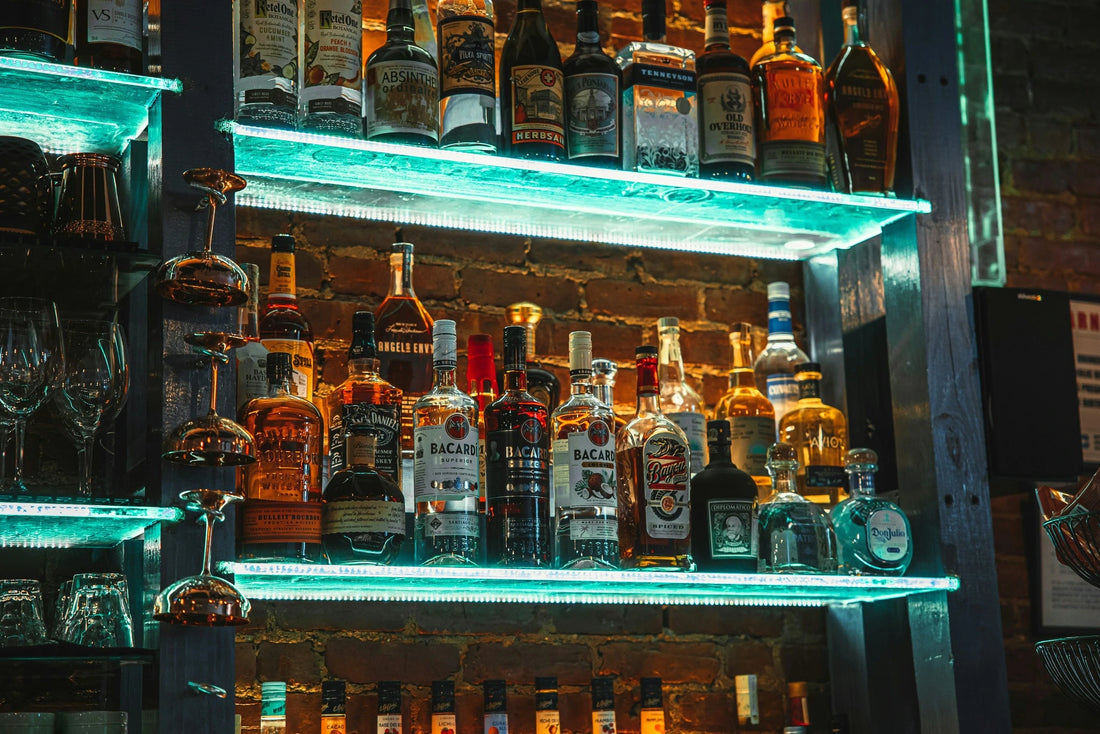
What is rum and how many types of rum are there?
This blog post covers what is a rum as well as the many types of rum, from white, golden, dark and black through to flavoured and spiced rum.
Table of Contents
The different types of rum
White, light, or clear rum
Gold, golden or pale rum
Dark rum
Overproof rum
Rhum agricole
Flavoured or spiced rum
Black rum
Cachaça
Navy rum
Premium aged rum
Aguardiente
Vintage Rum
Queen's Share Rum
Different ways of enjoying rum
The different types of rum
A quick visit to any supermarket will soon make you realise that there are many different types of rum on the market. The huge variety of types and flavours is driven by increasing customer demand to try new and interesting brands and tastes.
Let's start with a definition of a rum. Although it has not been specifically defined within the United Kingdom, the United States definition is that it is an alcoholic spirit, distilled from sugar cane or any of its by-products, including molasses, sugar cane juice or sugar cane syrup. The resulting distillate should be no less than 80 proof (40% ABV or Alcohol By Volume) alcohol content. However, strictly speaking, sugar from sugar beet is not the same as sugar from sugar cane, and therefore, the spirit made from sugar beet would not technically be considered a rum.
White, light, or clear rum
These are also known as silver rums and are generally the least complex of the various types, due to them often being bottled straight from the still. They can also be used as a basis for other types, although some can be stored in barrels for up to several years and then filtered to remove the resulting colour. Due to their fresh flavour, they can make an excellent addition to cocktails, as their taste is not overpowering on the palate, with flavours such as dried fruit, honey or vanilla coming through when sipped neat. This type often forms an essential component of cocktails such as mojitos, daiquiris, and piña coladas.

Gold, golden or pale rum
These are also known as Oro or Ambre rum and are often aged in oak barrels, taking on an amber or golden colour as a result. Whilst there are no strict aging rules, these varieties are usually aged for longer than white rum and have a complexity to the taste, coming from the aging process. Golden rum can vary between light and fragrant through to rich and intense and are often blended together. Depending on the length of time spent in the barrel, tastes of vanilla, almond, coconut, banana, and butterscotch can be found in this group of medium bodied, mellow rums.
Dark rum
Dark rum refers to a group of rums that are darker in colour than white rum. The dark, rich colour can be achieved by aging them in barrels for a considerable time, often resulting in an oak flavour. However, this colour may also be achieved by adding burnt sugar or caramel during the production process. As a result, a wide range of flavours accompany this group with the different variations being used to add colour and/or a smoky flavour to cocktails, such as the Mai Tai or Hurricane.

Overproof rum
In general, most standard rums are between 80 to 100 proof (40% to 50% ABV) but there are others which have a higher concentration of alcohol, known as overproof rums. Generally speaking, the manufacture process produces a spirit between 160 and 190 proof. The resulting liquor is then diluted with water to reduce it to the 80 proof standard. However, overproof rums do not go through the dilution process and are bottled at the higher proof level. In the United States, rum over 155 proof is not permitted entry, and it is common for manufacturers to bottle at the 150 proof level. Overproof rums tend to be popular in the West Indies and are used in cooking recipes where the rum needs to be set alight. Classic rum punches are often made using this type of spirit and are mixed with tropical fruit juices, to deliver a stronger taste. In Germany, the rumtopf recipe uses this type to mature and preserve a selection of fruit, to create a preserve, often served with cream, throughout the winter holidays.
Rhum agricole
This group comes in various colours and complexities, as the only defining characteristic is that the liquor is made from sugarcane juice. Although it is made principally in the French Caribbean Islands, especially Martinique and Guadeloupe, there are also versions made in Mauritius and Haiti. Due to the short season (1st April to 30th June) and the fact that sugar cane starts to degrade almost as soon as it is harvested, the juice needs to be fermented and distilled almost immediately. Within 24 hours, it is possible to lose up to 3% of the sucrose, so speed is of the essence. The sugar cane juice is double distilled to around 140 proof, which is lower than that produced by other sugar by-products. As a result, the spirit retains more of the flavour of the sugar cane juice. It is, therefore, common to taste a fresh, floral, almost grassy, flavour when drinking the spirit. The rhum can be rested for up to six months before being bottled as rhum blanc. Alternatively, the rhum can be matured in oak barrels for a number of years, resulting in a darker colour and a deeper flavour. At the three year mark, the rhum can be bottled and labelled as rhum vieux (old rum).

Flavoured or spiced rum
As the name suggests, this group involves the addition of extra herbs and spices, to the mix. Common additions include cinnamon, ginger, cloves and nutmeg as well as vanilla, allspice and pepper. Flavoured rum additions can include seeds, dried fruit, roots, leaves, or bark from edible flora. The wide variety of products in this group is testament to its popularity and the diverse range of ingredients used. Some of these rums originated as medicinal cures for a plethora of ailments. This group can be sipped neat or form part of a cocktail, such as the Dark & Stormy, as well as being used in recipes, such as rum cake.
Black rum
Generally, a black rum is one that has been left in oak barrels, longer than a gold rum. Often those barrels are significantly charred with some molasses left or placed within them. It is not unknown for burnt sugar or caramel colouring to be added to the finished product to further darken it. This type was first crafted by British settlers in the Caribbean in the 17th century and spread out across Europe and North America. It is reminiscent of an American whiskey/bourbon but sweeter. Being heavy bodied, black rum commonly tastes of dark chocolate, oak, tobacco, and leather.

Cachaça
This type of rum is the national spirit of Brazil, a key ingredient of the national cocktail (the Caipirinha) and has been produced since the 16th century. Like rhum agricole, it is made from fresh sugar cane juice but tastes a little gentler on the palate. Whilst much of the spirit is bottled with little or no interaction with barrels, those rums that are barrelled have many taste nuances, due to the different types of local wood being used. However, there are variations that do not use wood, such as, in Minas Gerais (Brazil), the artisanal cachaça is made using natural yeast and copper pots, in small batches.
Navy rum
These are full bodied, dark rums that are associated with the British Royal Navy. The connection goes back as far as 1655 when Jamaica was captured by the Royal Navy, and the local rum was used to provide a daily ration to each sailor. In fact, it was found that while grape based spirits, such as wine or brandy, went off in the heat of the Tropics, rum managed to improve its flavour as it aged in the barrels on board the ships. Admiral Edward Vernon is credited, around 1740, with watering down the spirit and adding lime, in order to prevent scurvy. The resulting mixture was nicknamed grog and later on, called tot. The custom of a daily tot per sailor continued until 31st July 1970.
Original Navy rum recipes used blends from all of the British Territories and in the 1800s, Alfred Lamb started making dark rum in cellars beneath the river Thames. Today, these spirits have a caramel sweetness, subtle vanilla, with warm spices, such as cinnamon, nutmeg and cloves, running through it.

Premium aged rum
These have been aged in barrels for a number of years, resulting in a rich, smooth spirit. The lengthy aging process means that some of the spirit evaporates off. It is common for this type of aged rum to be blended, in order to achieve a deep and distinctive flavour. The cost of storage and the loss of some liquor through evaporation means that these mature rums are often the most expensive. Aged rums are often darker in colour and there may be a reddish tint from the cognac or sherry barrels. Dependent on the country, there are different standards regarding the age statements on the bottle. For example, in the United States, a bottle that states 21 years, means that the youngest rum in the blend must be 21 years old.
Aguardiente
The name "Aguardiente" can be translated to mean "burning water" or "fire water" and is a spirit created by fermenting and distilling fruit and sugar cane, thereby retaining many of the flavours from the vegetation used to create it. Aguardiente is popular across Latin America, where it is often flavoured using lime, peach, or orange. In Columbia, however, the spirit is commonly flavoured with anise, with each region having its own variation.

Vintage rum
Vintage rums are bottled from specific vintage years of production and are, therefore, generally found on the French islands where the growing season is short. It has been known for a private label to purchase a large amount of rum from a particular year and age it until maturity. The master distiller must assess the sugar cane from each harvest and adjust the distilling process, in order to achieve consistency of flavour. These rums are often limited editions and are usually purchased by collectors. Vintage rums are labelled by the year they were distilled and the location of their origin.
Queen's Share Rum
Historically, it was produced in Jamaica and reserved for royalty, hence the name. The manufacturing process involves taking the low level alcohol from the final stage of the distillation process, saving it until there is sufficient volume for a full distillation. The result is then aged for four years and consequently, has a rich and complex taste. This type is rare, due to the complexity and the time consuming process, required to produce it.
Different ways of enjoying rum
There are many different ways to enjoy this spirit, but it is often based on personal taste and individual palate. Our recommendation would be to try different combinations, mixers and flavours and see for yourself. If you find a new way of enjoying our golden spiced rum, then please get in touch via social media.
Disclaimer
All content provided in this blog post is for informational and educational purposes only. The owner of this blog post makes no representation as to the accuracy or completeness of any information in this blog post or found by following any link within this blog post. The owner will not be liable for any errors or omissions in this information nor for the availability of this information. The owner will not be liable for any losses, injuries, or damages from the display or use of this information. These terms and conditions of use are subject to change at anytime and without notice.
